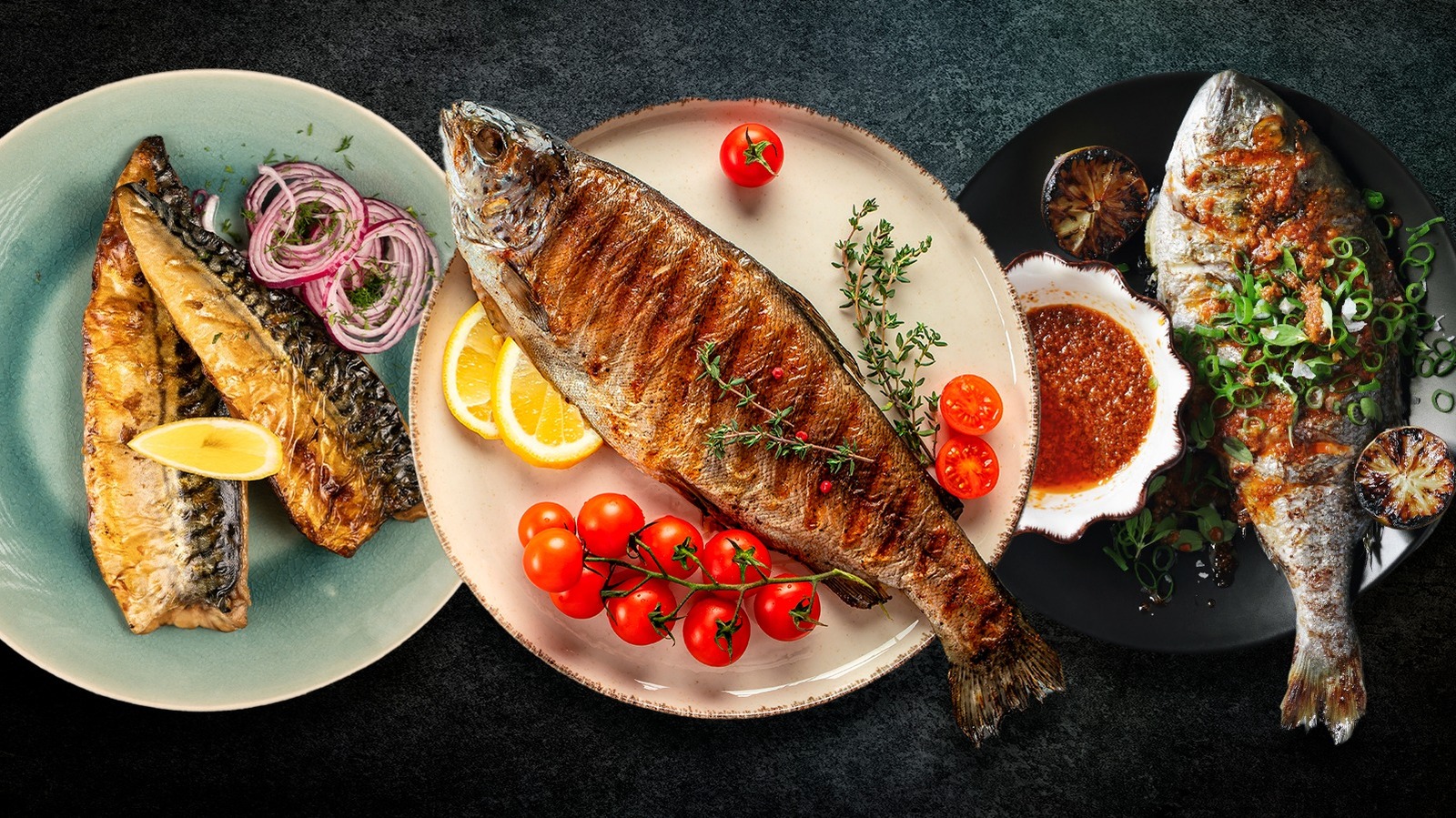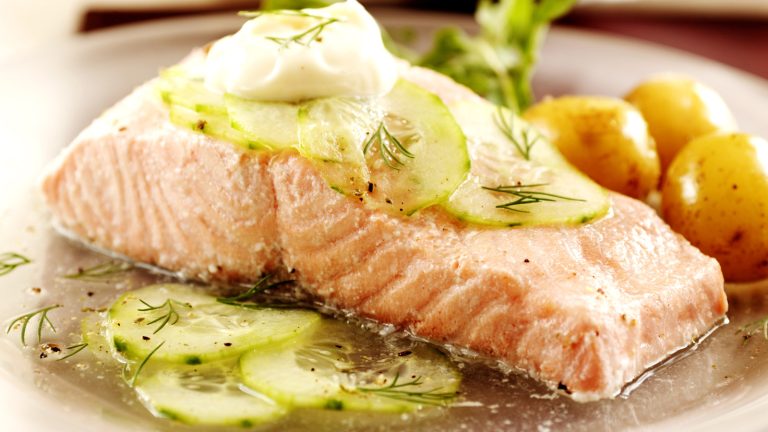If you own a grill, chances are you’re out there slapping some meat on it as soon as the weather warms up each spring. But meat isn’t your only option, of course. Grilling vegetables brings out their flavors, and many fruits are great on the grill, too. Also, if you live near the coast or a lake with good angling, you’ll know that fish is a great choice.
Now this is a subject that’s dear to my heart, as a chef and former restaurateur who was born and raised on Canada’s East Coast. Not only were my restaurants seafood-forward, I’m descended from a long line of fishermen (I even took a semester away from college to fish with my father and uncle).
Grilling does wonderful things for fish, just as it does for meat. Grilled fish gets that same tell-tale whiff of smoke flavor, the same tasty brown grill marks, and the same quick, high-temperature cooking. The main difference is that while meats and poultry are reliably sturdy enough to grill, not all fish can stand up to the heat and handling. So to stack the odds in your favor, here are 12 fish that cook well on the grill.
1. Salmon
There are three broad rules about picking fish to grill. Each rule has its exceptions, but firm-fleshed fish grill better than delicate, flaky fish; thick cuts fare better than thin ones; and rich, fatty fish do better on the grill than lean fish.
Salmon ticks all three of those boxes. Its flesh is rich, fatty, and firm, and the portions you’ll find at your local fishmonger or supermarket are almost always in that “inch thick, give or take” range that’s ideal for grilling. Add to that its versatility and near-universal popularity, and you have a winner.
But, some kinds of salmon are better for grilling than others. Your value option is usually farmed Atlantic salmon (wild stocks are too depleted to harvest, though I’m old enough to have done it). Wild-caught Pacific salmon is also widely available, though at a higher price, especially for premium King salmon (aka Chinook). Here is the real difference between farmed versus wild-caught salmon.
2. Swordfish
Just like the jungle or the Savannah, the ocean has its share of big apex predators. Large, strong-swimming fish, including swordfish, are much-loved for grilling because their powerful muscles develop a texture that’s more steak-like than fish-like.
The sheer size of a swordfish or a big tuna means you’ll typically find it in the form of thick steaks, which — fortuitously — are ideal for grilling. You’ll also seldom see a bone in a piece of swordfish, because you’ll almost be at the tail before you cut into bone.
One thing to be aware of with swordfish is that it’s leaner than a lot of the other options on this list. That means it can become dry if you overcook it, which would be a terrible waste. For the most flavorful grilled swordfish, give it a quick marinade and keep its final temperature in the 130 to 140 degrees Fahrenheit range. Alternatively, if you can find it, look for swordfish belly. As with tuna or salmon, its belly meat is lush and rich, which makes it extra flavorful and even better for grilling.
3. Tuna
Like swordfish, bluefin tuna are massive apex predators with an extra-firm, meaty texture. The difference is that bluefin is darker in color and bolder in flavor. Over the past decade or two it has become easier to find, either fresh or flash-frozen (which is not a compromise at all, it preserves the fresh-caught quality).
The best tip for tuna steaks is to grill them hot and fast, so the exterior sears beautifully but leaves the interior rare to medium-rare. Tuna is often another very “meaty” choice, and is best when cooked to rare or medium-rare. The steaks vary in fattiness, so look for nice bands of muscle and fat when you’re buying them (rather like buying a well-marbled steak). The belly meat is much richer, as with swordfish, but tends to go to pricey sushi restaurants. If you’re looking for a richer cut, grilling the tuna collar is a good option (you’ll probably need your fishmonger’s help to find one).
Bluefin gets most of the love, but don’t sleep on other tuna varieties if you can find them. Several other common kinds of tuna are excellent on the grill, including albacore and ahi (which have a relatively mild flavor), or bigeye, bonito, or skipjack, which have bolder flavors. When I lived on the West Coast years ago, I used to buy whole frozen bonito from a little Chinese shop in my neighborhood, and it was great for grilling.
4. Snapper
Let’s take a bit of a turn away from those giant ocean predators for a moment, and take a look at something that’s a bit more approachable: snapper. Snapper is a smaller fish, so you can find it sold whole at your local fishmonger or supermarket.
You’ll have some options with snapper. Larger fillets may be cut into two or more portions, or you can buy whole fillets of smaller snapper, or just buy snapper as a whole fish. There are a couple of good reasons to buy whole, if you can. For one thing, it makes for a really bold presentation when you put it on a plate (as a chef, I appreciate that). As a practical matter, grilling smaller fish whole also addresses the thickness issue, and makes it harder to overcook. Finally, buying a whole fish makes it easier to guarantee you’re getting what you think you’re getting, because red snapper is often the subject of seafood fraud.
Fillets (with or without skin) are easy to grill, and just need light seasoning. In the case of skinless fillets, you might want to use a grilling basket just for insurance against the fillets breaking. I suggest you grill whole fish the way Bobby Flay does, by making slashes through the thick parts (an inch or two apart) to help it cook as quickly as the thinner parts. You’ll need to practice serving fish from the bone, but eating grilled fish isn’t exactly unpleasant homework!
5. Mahi mahi
When I was a kid, mahi mahi was still called “dolphin,” which was pretty confusing and alarming for a youngster. It turns out I wasn’t the only one who found that confusing, so the older names of “dolphinfish” and “dorado” are seldom seen anymore. Hurray for a successful rebranding, right?
Between that trendy new name and some other bits of canny marketing, mahi mahi has become a lot more available in recent years. Don’t get me wrong, it’s still a premium product and you’ll pay accordingly, but it’s totally worth the price. Like most of the other fish on this list, it’s thick and meaty, with a delicately pale pink color (not unlike swordfish) when it’s uncooked.
Mahi mahi has a less assertive flavor than salmon or tuna, though it’s more distinctive than most kinds of white fish. It works well with most seasonings or marinades, though you can definitely overwhelm its own natural flavor if you’re too heavy-handed. Also, if you go the marinade route, an hour is the longest any fish should stay in an acidic marinade because it changes the fish’s texture (it’s a common mistake people make with mahi mahi).
6. Trout
Biologically trout are close kin to salmon (the whole family is referred to collectively as salmonids, and also include more exotic options like arctic char). Like its big cousin, trout is also relatively rich, usually pink in color, and surprisingly good on the grill.
You can go in a couple of different directions with trout. Steelhead is widely available at fishmongers and supermarkets, usually in big, salmon-like slabs or individual portions. Those, you cook more or less exactly the same as salmon (they’re not as rich, so they’ll cook a little more quickly).
Then there are smaller, pan-sized trout, either farmed from the store or fresh from your nearest stream or lake (one of the first things I learned to cook for myself, as a small boy was fresh-caught trout). You can fillet trout and grill the fillets, with or without skin, but I find it pays to grill trout whole because it is more fragile than many of the fish on this list. Trout holds together better with the bones and skin in place (you can use a grilling basket, for added confidence), and it is super easy to remove from the bone once it is done. Just slide a fork or fish server along the backbone to separate the meaty back from the spine, then flip the fillet over onto a plate. The rib bones will mostly stay behind, and any stubborn ones are easy to spot and remove.
7. Halibut
There aren’t a whole lot of flat fish that work on the grill, barring maybe a few local favorites. There are a lot of reasons for this. One is that their oddball anatomy means their fillets are thinner (and therefore less suitable) than comparably-sized round fish. If you cook them whole, you also have to contend with that anatomy when you serve your portions. Finally, many flat fish are naturally very delicate in texture, which is not what you want on the grill.
One notable exception to this rule is halibut. That’s partly because of its size: Pacific halibut average 20 to 50 pounds, while Atlantic halibut average 50 to 100 pounds, and record fish weigh hundreds of pounds. That means the fillets (or steaks) are plenty big enough to make grill-worthy cuts. Second, its white flesh is firm and holds up beautifully on the grill. You’ll find it in retail stores in the form of bone-in, cross-cut steaks from the thinner tail end, and fillet portions or fillet steaks from the larger sections of the fish.
Halibut is a big favorite of mine and I used to serve it at my restaurant, sometimes grilling it over charcoal on my Big Green Egg. Again, it’s a lean fish so you need to be careful not to overcook it. Also, its flavor is delicate and easily overwhelmed, so like any white fish on the grill it’s best to season it simply so its own flavor can shine through.
8. Mackerel
Mackerel is different from most of the fish on this list, for a few reasons. One is that this type of fish is very budget-friendly. A second is that the flesh is quite soft, and the fillets are thin, so it’s almost mandatory to cook mackerel with the skin on (and ideally whole).
Mackerel is a particular favorite of mine, because it is deeply flavorful and it’s one of the richest-tasting fish in this roundup. To put that same thought another way, mackerel is exactly the kind of “oily” fish we’re supposed to eat more often because of its high omega-3 content. Better yet, when mackerel is in season on either coast, you can buy it fresh at really affordable prices. In between seasons, blast-frozen mackerel is a high-quality option.
LIke most other “red” fish, mackerel’s flesh is darker in color and has a rich, distinctive flavor. It’ll stand up to some fairly aggressive seasoning, so you can have fun with spice rubs, and it also plays nicely with marinades. In fact, because of its richness, a bit of acidity in the form of a marinade, some grilled fruit, a splash of vinegar or a squeeze of citrus is a really appealing option with mackerel. Here where I live it’s common to slice raw onion into white vinegar, let it infuse for a couple of hours, and serve both the onions and the flavored vinegar with the fillets — but there are certainly more refined options as well.
9. Panfish
When you think of a perfect summer day, what kind of picture do you form in your head? If it involves several hours of lazing in the sunshine, casting a line into your nearest lake or river, you’ll be happy to know that most of the common and popular panfish species — crappy, bluegill, perch, and so on — all work pretty well on the grill.
You wouldn’t necessarily think so at first blush, because they tend to be relatively small and thin and have flaky flesh. Those things are perfectly true, but you can counter them all simply by grilling your panfish whole. As with trout, keeping the bones and skin in place helps panfish hold together nicely. You’ll just need to scale the fish first, and trim the fins away with a pair of kitchen shears (otherwise they’ll burn), and then you’re good to go.
If casting for panfish is your idea of the perfect day, you’ll be happy to know that most of the popular panfish species grill pretty well, at least with the skin on. They’re relatively lean, taste good, and the skin grills up beautifully crisp.
10. Sturgeon
As you’ll have gathered by now, I’m a big fan of grilling fish with the skin on. It helps protect the flesh from the grill’s heat, it helps hold the fish together, and best of all, it cooks to a crisp and delicious texture. But with some fish, the skin is either inedible (or at best, needs special handling) and sturgeon is just about at the top of that list. The skin of these ancient creatures is so thick and leathery that it’s practically armor, which is why it’s sold skinless.
When you see sturgeon at the fishmonger it’s usually sold in the form of skinless fillet portions, or sometimes (with large sturgeon) thick-cut steaks. It’s a more-or-less white fish, depending on the species, though it usually leans more to a pearlescent gray or pink hue than a pure white. It’s got a very firm, meaty texture — more so even than the other “meaty” fish I’ve cited here — and a mild, pleasing flavor. If you’re grilling it, you can get away with bold flavors because of its solid meatiness (I served it with a fruit and habanero salsa).
Fresh sturgeon is only regionally available, because so many species are at risk or endangered (there’s a healthy sturgeon population in Idaho), but you can order it online if you’d like to try it. At my restaurant, I was lucky; I had two local suppliers to choose from (one farmed, one wild-caught) because our local sturgeon population is stable as well.
11. Shark
I’ve described several of the fish on this list as apex predators, and they are, so you won’t be surprised to know that shark — the apex predator that ranks highest in the sea — is also a pretty good choice for grilling. In practical terms shark meat looks, cooks, and tastes like swordfish, which is a good thing. Its texture can be slightly more delicate than swordfish, depending on the age and size of the shark it was cut from.
Though, there is one big potential “gotcha” with shark meat, which is its high urea content. That’s an evolutionary adaptation that helps sharks survive in salt water, but once they’re caught and killed the urea begins to decompose into ammonia. The very freshest shark will smell clean and briny like any other fish, but it quickly begins to develop that “window-cleaning spray” ammonia smell. A hint of ammonia is OK, but a strong ammonia smell tells you the shark is past its prime or was poorly handled after it was caught.
To get rid of that mild ammonia smell, a marinade will usually do the job. You can opt for an acidic, vinaigrette-style marinade or just soak it in milk or buttermilk, whichever you prefer, before grilling. A second thing to be aware of with shark meat is that, like other apex predators, it accumulates a lot of mercury. So enjoy it, but only in moderation, and ideally choose something else if you’re trying to avoid mercury in your diet.
12. Monkfish
Monkfish is about the ugliest thing you’ll see at the fishmonger. The fish’s big, bulbous head is filled with needle-sharp teeth, and mounted at the front of a thick, eel-like body. Yet, although it looks like something out of a nightmare, monkfish has a sweet and appealing flavor. In fact, it’s often described as “the poor man’s lobster,” partly for its sweet taste, and partly because its characteristically round fillet portions look a bit like a lobster tail.
Monkfish fillets are roughly the size and shape of a pork tenderloin, with a pleasingly white color and firm texture. It’s excellent on the grill, though despite the resemblance you don’t grill it like a lobster tail. The fillets are sold boneless and skinless, though there’s usually a layer of fine white membrane you’ll want to remove with a small, sharp knife before you cook the monkfish.
You can grill individual fillet portions of monkfish whole, or you can cut them into medallions and skewer them if you prefer. Be careful not to overcook it, because like swordfish it can become dry. Some cooks like to wrap monkfish in bacon or prosciutto, before putting it on the grill, which helps protect the fish from the heat of the grill. Better yet it adds flavor, and that crisp, savory pork coating plays with the sweet monkfish itself to give you a pleasing contrast of tastes and textures.





